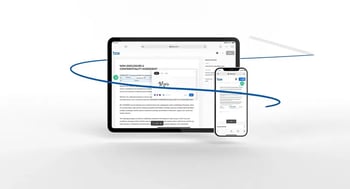The complete guide to creating explainer videos in 2023
Videos can explain complex offerings in ways that plain text or pictures simply can't, and are becoming increasingly crucial to your buyer's journey in 2023. Here's everything you need to know about making one.
Video makes information easier to understand and remember because your visual system activates over half of your brain, helping you to grasp concepts and data more easily. No surprise, then, that explainers are the most popular type of video — especially for those in the research stage of their buyer journey.
In this lengthy article, we're going to go through everything you need to know about explainer video production in 2023. If you want to skip to different sections, we've anchored some links here:
-
WHAT DOES AN EXPLAINER VIDEO DO?
-
WHAT MAKES A GOOD EXPLAINER VIDEO?
-
WHAT TYPES OF EXPLAINER VIDEOS ARE THERE?
-
WHAT SHOULD AN EXPLAINER VIDEO INCLUDE?
-
How long should an explainer video be?
-
HOW DO I MAKE AN EXPLAINER VIDEO?
What does an explainer video do?
Explainer videos are bite-sized videos that turn complex ideas into easy-to-digest entertainment pieces for your ideal audience.
It's known that viewers retain 95% of a message when they watch it in a video compared to 10% when reading it in text, a mind-melting half a billion people watch videos on social media every day, and it’s estimated that video traffic represents 82% of all consumer online traffic.
And because of the diverse nature of video content, there are endless ways to clearly explain your message to your audience.
What makes a good explainer video?
A good explainer video entertains as much as it educates. It starts by setting clear goals and objectives and having an unquestionably deep insight into who your audience is. And we're not talking demographics here! We're talking about their likes, dislikes, personalities, and things they care most about. Go deeper to uncover what truly makes them tick.
You also need to consider that the average attention span is about 8 seconds long these days, so you need to be able to spark their curiosity and hook them within those first 8 seconds.
By starting with a solid brief that encapsulates all this, you'll ensure your explainer video has the best chance of being captivating, inspiring and driving results.
What types of explainer videos are there?
PRODUCT EXPLAINER VIDEOS
Product explainers are designed to offer more information about your product, allowing you to drill down into specific product benefits and features.
APP EXPLAINER VIDEOS
App explainers can help your customers discover hidden features or show them how to get started. Explainers are popular with brands releasing new apps, features, and platforms as a way to quickly get their message across in the most engaging and enticing way.
SERVICE EXPLAINER VIDEOS
Want to give people a window into what it's like to work with you? Service explainers are a great way to showcase what a customer can expect and how your organisation runs things, so your audience can feel much more confident in your service.
What should an explainer video include?
The best explainer videos out there include most of the following features:
- One clear, simple message. The clearer your message is, the easier it is for your audience to understand and get on board with it.
- Visual cues. If your product or service is complex and abstract, explainer videos are a great way to join the dots, engage your audience, and help your message come across clearly.
- Your brand identity. By featuring your tone of voice, your brand colours, logos, and other visual markers, your video will be recognisable against competitors.
- A use case or testimonial. Let the results speak for themselves!
- A call to action. To persuade viewers to look further into your business' product or services.
How long should an explainer video be?
Your audience’s attention is valuable. You’ll be working hard to get it in the first place, so it pays not to waste it once you have it. And this means being concise in your communication. The shorter, the better.
However, generally speaking, most explainer videos are around 90 seconds long. This gives you enough time to get your point across without bombarding your potential customer with information.
If you feel that your explainer does need to be longer, then this is still possible - just make sure the info you are including adds value.
Want to see an example? Here's an explainer video that Venture created for Europa Flow!
How do I make an explainer video?
Step 1: DECIDE ON YOUR VIDEO OBJECTIVE
Don't fall into the trap of wanting to create a video for all the wrong reasons.
Here are some really, really bad reasons for wanting video (they might be part of why you want video, but they shouldn't be the only reasons):
- You just feel like you need video
- You want to be able to show off to your friends and family
- You're jealous because everyone else has video
- You don't think your marketing efforts are really awesome until they include video
Why are these reasons so terrible?
Well, they're not firm goals. There's no way to measure your success against them, because there's no way to measure how much less jealous you feel or how much more awesome your marketing is with video (at least not objectively).
That means you're setting yourself up for failure before you've even started.
You need to remember that video itself is a format.
So rather than thinking: We should create a video! It could explain our services! It's better to think: We should explain our core services to potential customers! And then work out the best way to express that content, whether that's through video or otherwise.
In practice, that means you should know what you want to achieve and what you want to tell your audience before you even start to think about if video is the best way to get there. Because that will tell you if video is even the best format for your message.
Hey, that might be a bit controversial coming from a video production company. But it's the right way to do it.
Anywhoo, let's move on to actually setting out your objectives.
I) IDENTIFY YOUR BUSINESS SITUATION AND ISSUES
Your objectives are most likely to blossom naturally from a problem, weakness, or opportunity for your business. So you'll need to start with an up-to-date SWOT analysis of your business.
Ask yourself how your business and its marketing efforts are doing and where your strengths and weaknesses currently lie.
Be as detailed as you can, but don't worry about getting every single thing down. This doesn't need to be War and Peace. It just needs to give an accurate view of where your business is at, where it's acing things, and where it could improve.
II) PICK YOUR PROBLEM
Call me Ishmael, because it's time to find your own Moby Dick.
From the information you've filled out, decide which of the issues facing your business you want to try and fix (or opportunities you want to go after).
III) LINK IT BACK TO your marketing STRATEGY
Do you have any wider goals currently in place that your explainer video content could contribute towards?
You want to be certain that whatever videos you create tie into your bigger aims and are relevant to where you're heading as a business.
So write down which higher-level goals your video content will feed into.
For example, by tackling poor conversion rates you might be helping to meet your business goal of generating 200 new customers this year.
IV) CONSTRUCT YOUR OBJECTIVE
Okay, it's time to get that objective down.
Keeping your problem or opportunity in mind, turn it into an objective that will also help achieve your bigger goal.
Most importantly, you need to make sure your objectives are SMART.
That means:
- Specific (not vague)
- Measurable (ideally containing statistics you can track)
- Achievable (realistic considering the circumstances)
- Relevant (tied into your wider business goals)
- Time-bound (within a set deadline).
V) SPECIFY HOW YOU'LL MEASURE SUCCESS
This is something people often forget to do, but it's so important to track how your video content is performing.
Be sure to note down specifically what numbers, statistics, or video metrics you'll need to keep an eye on to see how and when you hit your objectives.
And use the exact figure that you're aiming to achieve, so there's no room for confusion.
VI) MAKE NOTE OF YOUR STAKEHOLDERS
Finally, write down anyone who might need to be aware of or sign off on your video objectives.
This might be a Marketing Director, the owner of the business, or your direct superior. Or all three.
Whoever will need to know, it's pertinent to start getting them involved now. That way you won't come up against any surprise roadblocks further down the road.
And if you're lucky enough to have sole control over your video content, leave this part blank!
SOME COMMON VIDEO goals & OBJECTIVES
Okay, I've shown you the process you need to follow to come up with your objectives, but you might still be struggling for inspiration. Well, the truth is: video can be used to achieve almost anything.
At the end of the day your objectives are going to rely heavily on your marketing strategy and the overall aims of the business.
But to help get you started, here are some of the most common objectives for explainer videos:
- Increasing user retention and engagement
- Converting leads
- Increasing sales
- Launching a new product or service
- Providing customer support.
Don't feel limited by these. Done right, video content can reach any goal.
Step 2: RESEARCH YOUR TARGET AUDIENCE
Your audience might well be the single most important aspect of your explainer video. And you're going to have to get to know them even better to do this thing right.
If you haven't done enough research into your target audience, there's no way you'll be able to create a video that appeals to them and engages them. That speaks to their heart.
In practice, that means going way beyond simple demographics like age, gender and location.
It means getting to know your audience as people.
Step 3: WORK OUT YOUR CORE MESSAGE
So, wild guess here, but I'm betting you have something you want to explain to your audience.
But what action do your target audience need to take to make it a reality? And what state of mind will lead them to that action?
In other words, what do you want your target audience to:
- Feel?
- Think?
- Do?
Let me give you an example. If we want to increase our conversion rate on our product page to 3% (and considering what we found from our research) then we want our audience to:
- Feel: invigorated, and excited to get started
- Think: our product will offer more than our competitor(s)
- Do: purchase our software
BOIL DOWN THE CORE MESSAGE
Next, we have to work out the one thing your audience needs to know to encourage them to feel, think and act that way.
I strongly suggest you focus on a single core message. The more precision you have on what you want to say, the less diluted your point will be.
Think of your video content like a laser, dividing your video between different messages is like separating the laser into different beams. Each message becomes weaker overall.
But if you leave the laser as a single beam, your message emerges far stronger.
So what's your core message? What do you need to get across to your target audience so they will think, feel and do what you're setting out for them to do?
You basically have to infer this from everything you've discovered so far.
In our example, our core message would most likely be:
Our software offers [core benefit] to a higher standard than our competitors, and here's how it does that.
Got it?
Step 4: Create your strategy
All the above boils down to strategy, which is at the heart of your video production. Without a clear strategy filled with the above insights, your video is going to be just a load of pretty imagery. Which is great and all, but it'll probably miss the mark when it comes to speaking clearly to your target audience.
Your video marketing strategy will ultimately be what guides you — in terms of your budget, your timelines, your production processes, your conversion metrics, and even where your video is going to live. In other words, all the things you need to create a bangin' brief for the creatives who will be working on your corporate video.
If you've not done that strategic thinking yet, we can help you look at your objectives, goals and audience and support you on this journey. We manage projects where clients have had no video experience, all the way through to those very familiar with the medium and what’s involved.
Have a gander at our strategy services and get in touch!
STEP 5: YOUR VIDEO PRODUCTION BRIEF
Now, this document is probably the most important part to get right. Here, you need to combine all of your thoughts into one place to ensure no important planning is missed.
Whether you're creating video internally or working with a video agency, your brief is vital to make sure everybody involved is working towards the same goal.
With decades of video production experience the team at Venture know what a great video brief looks like - so we've uploaded a video briefing template for you to download, free of charge.
DOWNLOAD OUR VIDEO BRIEF TEMPLATE
Kickstart your latest video project with our simple brief template. Learn how to lay out your brief properly and ensure your videos are produced simply & effectively.
Remember that the more detail you can include in your brief before production begins, the more likely your video is to be a success that engages your audience and meets your goals.
Our simple video brief template asks you all of these questions in even more depth, with preview examples. So now you know how to write a video production brief (and why), download our template and get started today!
STEP 6: THE CREATIVE BIT
Want to know how the corporate video production creative process works? Whilst every creative agency is different, we can give you some insight into how we do things here at Venture:
I) PROJECT BRIEFING
First, your video production team will begin by understanding your destination through your brief. They should be using it as a guiding principle throughout the whole of the video production process.
II) CREATIVE DEVELOPMENT
Then, your video production team will begin to develop strategic and creative ways of telling your story. They'll take your brief and get to work researching and creating mood boards to develop a key creative idea based on real insights.
III) CREATIVE PRESENTATION
Once ideas have been sparked, the real excitement begins as your video team presents their thoughts and creative ideas to you for feedback.
STEP 7: SCRIPT AND STORYBOARD
Once you’re happy with the direction of your video, it’s time for those working on your video (i.e. your chosen video production agency) to get to work on your video scripts and storyboards.
What’s a storyboard, you ask? A storyboard is a visual representation of your video sequence broken down into individual panels. It’s pretty much a series of ordered drawings that include camera direction, dialogue, and other important details. Essentially, it’s where the creatives sketch out how a video will unfold, shot by shot.
In order to tell your story in the most compelling way possible, you’ll need to ensure that the script for your video syncs well with what you have in mind visually.
STEP 8: ANALYTICS AND HOSTING
Understanding how and why your content is performing across multiple platforms and channels is vital for taking your marketing to the next level.
Regular analysis and reporting across a range of metrics and KPIs mean you can chart how close you are to reaching your objectives. And that means you can fine-tune your strategy and create even more powerful, compelling content.
You'll need to have a video analytics software in place that allows you to discover what your audiences are watching and benchmark against your competitors.
Wistia is our go-to video hosting platform at Venture. We use it for our clients' video content as well as our own, as it's specifically designed for businesses. What makes it one of the best video hosting sites on the market is its focus on data, customisation and ability to integrate with third-party services.
Once you publish your shiny new video on Wistia and the views begin to rush in, you'll have access to a whole host of advanced metrics to work out how close you are to your goals.
If you don't measure your video marketing properly, you can easily under-report the value it is providing and it will quickly start to look like a bad investment.
STEP 9: VIDEO ACTIVATION
A brilliant video won't go very far on its own. Planning where your video will live is vital to its success with your target audience. This is where you need to make sure your content is hitting your target audience in the right place, at the right time.
To start you off, let’s get thinking about some of the following questions, so you can decide where it's most worthwhile to invest your time, money and effort.
I) WHAT DO YOU WANT TO ACHIEVE?
Every business has its own goals, from boosting awareness to increasing sales to better engagement on social media platforms.
Your goal will ultimately shape what success looks like to you and whether your campaign has gone well. But it also defines how you should distribute your video.
Think about your sales funnel: consider whether you're trying to raise awareness, push leads, drive decision-making, or keep customers interested, then decide how your corporate video can help you do it.
For example, if you're launching something new? You should think about promoting your video with paid social. Helping customers out with an explainer video? Put long-form content on YouTube for them to view while they research.
II) WHO IS YOUR AUDIENCE?
Time to look back on your personas. Think about the channels they use, the shows they watch, and ultimately, which platforms are worth pursuing.
Is there anything your target customer is looking for or expecting from your sector? Knowing the answers to all these questions will help you figure out the best platforms to achieve your goals.
For example, you might know you want to use social media advertising to boost awareness, but your target market is under 18s. So, you're better off using TikTok or Instagram, which have more users in that demographic than Facebook.
Or, if you know you want to speak to an audience that watches DIY shows, you might think about spending on pre-roll ads or Sky AdSmart.
Most people in the research stage of their buyer journey head over to Youtube or Reddit for answers, so maybe that's where your video is best off being published.
Ultimately, to reach the right people you have to be in the right place, because if you don't think it through from the start, you risk wasting your budget, and your chances.
III) DO YOU HAVE THE RIGHT FORMATS?
Once you've answered the questions above, you should have an idea of how you want to activate your video. But just as one video won't work for all people, on a technical level, it won't work for all channels, either.
That doesn't mean you necessarily have to create additional content, though. It's often a case of adapting what you have for different platforms.
It's worth setting aside some budget to create edits of your video, so it can be trimmed and tailored for all kinds of applications (more on that on p. 7 of our Video Activation Guide).
If you're not confident or comfortable with doing this, ask us to step in and take the reins.
IV) WHAT'S YOUR advertising BUDGET?
93% of marketers agree video is an important part of their marketing strategy (HubSpot), but whether you're using social media, TV (be that connected or traditional) or another channel, budget is crucial.
It all depends on what you're trying to achieve and which platforms you use. But, even a small budget will stretch further than you think.
TV is no longer just for big brands; there are lots of advertising options on connected TV, streaming and on-demand platforms, which allow you to target specific audiences too.
And on social media, you might want to invest in more targeted advertising to reach particular people, or to give your video content a wider reach.
You'll always need to set some money aside for media spending, or you won't be able to get your video out there, but if you're unsure how to use it wisely, we can help.
READY TO START YOUR explainer VIDEO PRODUCTION?
Whether you've got a spark of an idea or a fully-formed plan, our door's always open. And it all starts with a conversation. Call us up or send an email to book a kick-off meeting, where we'll build a picture of your brand, talk you through our process, timings and costs, and decide the next steps.

Written by Emily Malone Marketing Manager for Venture — a full-service video production agency that specialises in producing creative videos & campaigns that get real results.


























